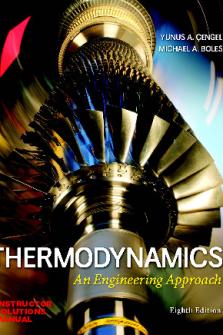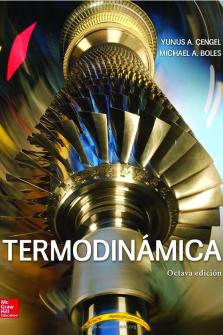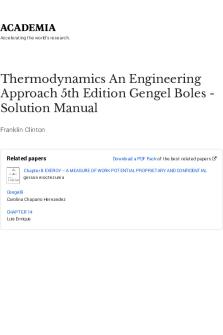Termodinamica. Solucionario. Cengel & Boles. 8va edición. (Thermodynamics. Solutions manual. 8th edition) PDF

| Title | Termodinamica. Solucionario. Cengel & Boles. 8va edición. (Thermodynamics. Solutions manual. 8th edition) |
|---|---|
| Author | Soph Prz |
| Pages | 2,041 |
| File Size | 24.5 MB |
| File Type | |
| Total Downloads | 759 |
| Total Views | 1,198 |
Summary
INSTRUCTOR SOLUTIONS MANUAL 1-1 Solutions Manual for Thermodynamics: An Engineering Approach 8th Edition Yunus A. Cengel, Michael A. Boles McGraw-Hill, 2015 Chapter 1 INTRODUCTION AND BASIC CONCEPTS PROPRIETARY AND CONFIDENTIAL This Manual is the proprietary property of McGraw-Hill Education and pro...
Description
INSTRUCTOR SOLUTIONS MANUAL
1-1
Solutions Manual for
Thermodynamics: An Engineering Approach 8th Edition Yunus A. Cengel, Michael A. Boles McGraw-Hill, 2015
Chapter 1 INTRODUCTION AND BASIC CONCEPTS
PROPRIETARY AND CONFIDENTIAL This Manual is the proprietary property of McGraw-Hill Education and protected by copyright and other state and federal laws. By opening and using this Manual the user agrees to the following restrictions, and if the recipient does not agree to these restrictions, the Manual should be promptly returned unopened to McGraw-Hill Education: This Manual is being provided only to authorized professors and instructors for use in preparing for the classes using the affiliated textbook. No other use or distribution of this Manual is permitted. This Manual may not be sold and may not be distributed to or used by any student or other third party. No part of this Manual may be reproduced, displayed or distributed in any form or by any means, electronic or otherwise, without the prior written permission of McGraw-Hill Education.
PROPRIETARY MATERIAL. © 2015 McGraw-Hill Education. Limited distribution permitted only to teachers and educators for course preparation. If you are a student using this Manual, you are using it without permission.
1-2 Thermodynamics
1-1C Classical thermodynamics is based on experimental observations whereas statistical thermodynamics is based on the average behavior of large groups of particles.
1-2C On a downhill road the potential energy of the bicyclist is being converted to kinetic energy, and thus the bicyclist picks up speed. There is no creation of energy, and thus no violation of the conservation of energy principle.
1-3C A car going uphill without the engine running would increase the energy of the car, and thus it would be a violation of the first law of thermodynamics. Therefore, this cannot happen. Using a level meter (a device with an air bubble between two marks of a horizontal water tube) it can shown that the road that looks uphill to the eye is actually downhill.
1-4C There is no truth to his claim. It violates the second law of thermodynamics.
Mass, Force, and Units
1-5C Kg-mass is the mass unit in the SI system whereas kg-force is a force unit. 1-kg-force is the force required to accelerate a 1-kg mass by 9.807 m/s2. In other words, the weight of 1-kg mass at sea level is 1 kg-force.
1-6C In this unit, the word light refers to the speed of light. The light-year unit is then the product of a velocity and time. Hence, this product forms a distance dimension and unit.
1-7C There is no acceleration, thus the net force is zero in both cases.
1-8 The variation of gravitational acceleration above the sea level is given as a function of altitude. The height at which the weight of a body will decrease by 0.3% is to be determined. z Analysis The weight of a body at the elevation z can be expressed as
W mg m(9.807 332 . 106 z) In our case,
W (1 0.3 / 100)Ws 0.997Ws 0.997mg s 0.997(m)(9.807) Substituting,
0 6
0.997(9.807) (9.807 3.32 10 z) z 8862 m
Sea level
PROPRIETARY MATERIAL. © 2015 McGraw-Hill Education. Limited distribution permitted only to teachers and educators for course preparation. If you are a student using this Manual, you are using it without permission.
1-3 1-9 The mass of an object is given. Its weight is to be determined. Analysis Applying Newton's second law, the weight is determined to be
W mg (200 kg)(9.6 m/s 2 ) 1920N
1-10 A plastic tank is filled with water. The weight of the combined system is to be determined. Assumptions The density of water is constant throughout. Properties The density of water is given to be = 1000 kg/m3. Analysis The mass of the water in the tank and the total mass are
mtank = 3 kg
V =0.2 m
mw =V =(1000 kg/m )(0.2 m ) = 200 kg 3
3
3
H2O
mtotal = mw + mtank = 200 + 3 = 203 kg Thus,
1N 1991 N W mg (203 kg)(9.81 m/s2 ) 2 1 kg m/s
1-11E The constant-pressure specific heat of air given in a specified unit is to be expressed in various units. Analysis Using proper unit conversions, the constant-pressure specific heat is determined in various units to be
1 kJ/kg K 1.005 kJ/kg K c p (1.005 kJ/kg C) 1 kJ/kg C 1000 J 1 kg 1.005 J/g C c p (1.005 kJ/kg C) 1 kJ 1000 g 1 kcal c p (1.005 kJ/kg C) 0.240 kcal/kg C 4.1868 kJ 1 Btu/lbm F 0.240 Btu/lbm F c p (1.005 kJ/kg C) 4.1868 kJ/kg C
PROPRIETARY MATERIAL. © 2015 McGraw-Hill Education. Limited distribution permitted only to teachers and educators for course preparation. If you are a student using this Manual, you are using it without permission.
1-4 1-12
A rock is thrown upward with a specified force. The acceleration of the rock is to be determined.
Analysis The weight of the rock is
1N W mg (3 kg)(9.79 m/s 2 ) 1 kg m/s 2
29.37 N
Then the net force that acts on the rock is
Fnet Fup Fdown 200 29.37 170.6 N
Stone
From the Newton's second law, the acceleration of the rock becomes
a
F 170.6 N 1 kg m/s 2 m 3 kg 1 N
56.9 m/s 2
PROPRIETARY MATERIAL. © 2015 McGraw-Hill Education. Limited distribution permitted only to teachers and educators for course preparation. If you are a student using this Manual, you are using it without permission.
1-5
1-13 Problem 1-12 is reconsidered. The entire EES solution is to be printed out, including the numerical results with proper units. Analysis The problem is solved using EES, and the solution is given below. "The weight of the rock is" W=m*g m=3 [kg] g=9.79 [m/s2] "The force balance on the rock yields the net force acting on the rock as" F_up=200 [N] F_net = F_up - F_down F_down=W "The acceleration of the rock is determined from Newton's second law." F_net=m*a "To Run the program, press F2 or select Solve from the Calculate menu." SOLUTION a=56.88 [m/s^2] F_down=29.37 [N] F_net=170.6 [N] F_up=200 [N] g=9.79 [m/s2] m=3 [kg] W=29.37 [N] 200
160
2
a [m/s2] 190.2 90.21 56.88 40.21 30.21 23.54 18.78 15.21 12.43 10.21
a [m/s ]
m [kg] 1 2 3 4 5 6 7 8 9 10
120
80
40
0 1
2
3
4
5
6
m [kg]
7
8
9
10
PROPRIETARY MATERIAL. © 2015 McGraw-Hill Education. Limited distribution permitted only to teachers and educators for course preparation. If you are a student using this Manual, you are using it without permission.
1-6 1-14 A resistance heater is used to heat water to desired temperature. The amount of electric energy used in kWh and kJ are to be determined. Analysis The resistance heater consumes electric energy at a rate of 4 kW or 4 kJ/s. Then the total amount of electric energy used in 3 hours becomes Total energy = (Energy per unit time)(Time interval) = (4 kW)(3 h) = 12 kWh Noting that 1 kWh = (1 kJ/s)(3600 s) = 3600 kJ, Total energy = (12 kWh)(3600 kJ/kWh) = 43,200 kJ Discussion Note kW is a unit for power whereas kWh is a unit for energy.
1-15E An astronaut took his scales with him to space. It is to be determined how much he will weigh on the spring and beam scales in space. Analysis (a) A spring scale measures weight, which is the local gravitational force applied on a body:
1 lbf W mg (150 lbm)(5.48 ft/s 2 ) 32.2 lbm ft/s 2
25.5 lbf
(b) A beam scale compares masses and thus is not affected by the variations in gravitational acceleration. The beam scale will read what it reads on earth,
W 150 lbf
1-16 A gas tank is being filled with gasoline at a specified flow rate. Based on unit considerations alone, a relation is to be obtained for the filling time. Assumptions Gasoline is an incompressible substance and the flow rate is constant. Analysis The filling time depends on the volume of the tank and the discharge rate of gasoline. Also, we know that the unit of time is „seconds‟. Therefore, the independent quantities should be arranged such that we end up with the unit of seconds. Putting the given information into perspective, we have t [s]
V [L],
and
V
[L/s}
It is obvious that the only way to end up with the unit “s” for time is to divide the tank volume by the discharge rate. Therefore, the desired relation is
t
V V
Discussion Note that this approach may not work for cases that involve dimensionless (and thus unitless) quantities.
PROPRIETARY MATERIAL. © 2015 McGraw-Hill Education. Limited distribution permitted only to teachers and educators for course preparation. If you are a student using this Manual, you are using it without permission.
1-7 1-17 A pool is to be filled with water using a hose. Based on unit considerations, a relation is to be obtained for the volume of the pool. Assumptions Water is an incompressible substance and the average flow velocity is constant. Analysis The pool volume depends on the filling time, the cross-sectional area which depends on hose diameter, and flow velocity. Also, we know that the unit of volume is m3. Therefore, the independent quantities should be arranged such that we end up with the unit of seconds. Putting the given information into perspective, we have
V [m3]
is a function of t [s], D [m], and V [m/s}
It is obvious that the only way to end up with the unit “m3” for volume is to multiply the quantities t and V with the square of D. Therefore, the desired relation is
V = CD2Vt where the constant of proportionality is obtained for a round hose, namely, C =π/4 so that V = (D2/4)Vt. Discussion Note that the values of dimensionless constants of proportionality cannot be determined with this approach.
Systems, Properties, State, and Processes 1-18C The radiator should be analyzed as an open system since mass is crossing the boundaries of the system.
1-19C The system is taken as the air contained in the piston-cylinder device. This system is a closed or fixed mass system since no mass enters or leaves it.
1-20C A can of soft drink should be analyzed as a closed system since no mass is crossing the boundaries of the system.
1-21C Intensive properties do not depend on the size (extent) of the system but extensive properties do.
1-22C If we were to divide the system into smaller portions, the weight of each portion would also be smaller. Hence, the weight is an extensive property.
1-23C Yes, because temperature and pressure are two independent properties and the air in an isolated room is a simple compressible system.
PROPRIETARY MATERIAL. © 2015 McGraw-Hill Education. Limited distribution permitted only to teachers and educators for course preparation. If you are a student using this Manual, you are using it without permission.
1-8 1-24C If we were to divide this system in half, both the volume and the number of moles contained in each half would be one-half that of the original system. The molar specific volume of the original system is
v
V N
and the molar specific volume of one of the smaller systems is
v
V/ 2 V N /2 N
which is the same as that of the original system. The molar specific volume is then an intensive property.
1-25C A process during which a system remains almost in equilibrium at all times is called a quasi-equilibrium process. Many engineering processes can be approximated as being quasi-equilibrium. The work output of a device is maximum and the work input to a device is minimum when quasi-equilibrium processes are used instead of nonquasi-equilibrium processes.
1-26C A process during which the temperature remains constant is called isothermal; a process during which the pressure remains constant is called isobaric; and a process during which the volume remains constant is called isochoric.
1-27C The pressure and temperature of the water are normally used to describe the state. Chemical composition, surface tension coefficient, and other properties may be required in some cases. As the water cools, its pressure remains fixed. This cooling process is then an isobaric process.
1-28C When analyzing the acceleration of gases as they flow through a nozzle, the proper choice for the system is the volume within the nozzle, bounded by the entire inner surface of the nozzle and the inlet and outlet cross-sections. This is a control volume since mass crosses the boundary.
1-29C The specific gravity, or relative density, and is defined as the ratio of the density of a substance to the density of some standard substance at a specified temperature (usually water at 4°C, for which H2O = 1000 kg/m3). That is, SG / H2O . When specific gravity is known, density is determined from SG H2O .
PROPRIETARY MATERIAL. © 2015 McGraw-Hill Education. Limited distribution permitted only to teachers and educators for course preparation. If you are a student using this Manual, you are using it without permission.
1-9
1-30 The variation of density of atmospheric air with elevation is given in tabular form. A relation for the variation of density with elevation is to be obtained, the density at 7 km elevation is to be calculated, and the mass of the atmosphere using the correlation is to be estimated. Assumptions 1 Atmospheric air behaves as an ideal gas. 2 The earth is perfectly sphere with a radius of 6377 km, and the thickness of the atmosphere is 25 km. Properties The density data are given in tabular form as z, km 0 1 2 3 4 5 6 8 10 15 20 25
r, km 6377 6378 6379 6380 6381 6382 6383 6385 6387 6392 6397 6402
, kg/m3 1.225 1.112 1.007 0.9093 0.8194 0.7364 0.6601 0.5258 0.4135 0.1948 0.08891 0.04008
Analysis Using EES, (1) Define a trivial function rho= a+z in equation window, (2) select new parametric table from Tables, and type the data in a two-column table, (3) select Plot and plot the data, and (4) select plot and click on “curve fit” to get curve fit window. Then specify 2nd order polynomial and enter/edit equation. The results are: (z) = a + bz + cz2 = 1.20252 – 0.101674z + 0.0022375z2
for the unit of kg/m3,
(or, (z) = (1.20252 – 0.101674z + 0.0022375z2)109 for the unit of kg/km3) where z is the vertical distance from the earth surface at sea level. At z = 7 km, the equation would give = 0.60 kg/m3. (b) The mass of atmosphere can be evaluated by integration to be
m
dV
V
h
z 0
(a bz cz 2 )4 (r0 z ) 2 dz 4
h
z 0
(a bz cz 2 )( r02 2r0 z z 2 )dz
4 ar02 h r0 (2a br0 )h 2 / 2 (a 2br0 cr02 )h 3 / 3 (b 2cr0 )h 4 / 4 ch 5 / 5
where r0 = 6377 km is the radius of the earth, h = 25 km is the thickness of the atmosphere, and a = 1.20252, b = -0.101674, and c = 0.0022375 are the constants in the density function. Substituting and multiplying by the factor 109 for the density unity kg/km3, the mass of the atmosphere is determined to be m = 5.0921018 kg Discussion Performing the analysis with excel would yield exactly the same results. EES Solution for final result: a=1.2025166;
b=-0.10167
c=0.0022375;
r=6377;
h=25
m=4*pi*(a*r^2*h+r*(2*a+b*r)*h^2/2+(a+2*b*r+c*r^2)*h^3/3+(b+2*c*r)*h^4/4+c*h^5/5)*1E+9
PROPRIETARY MATERIAL. © 2015 McGraw-Hill Education. Limited distribution permitted only to teachers and educators for course preparation. If you are a student using this Manual, you are using it without permission.
1-10 Temperature
1-31C They are Celsius (C) and kelvin (K) in the SI, and fahrenheit (F) and rankine (R) in the English system.
1-32C Probably, but not necessarily. The operation of these two thermometers is based on the thermal expansion of a fluid. If the thermal expansion coefficients of both fluids vary linearly with temperature, then both fluids will expand at the same rate with temperature, and both thermometers will always give identical readings. Otherwise, the two readings may deviate.
1-33C Two systems having different temperatures and energy contents are brought in contact. The direction of heat transfer is to be determined. Analysis Heat transfer occurs from warmer to cooler objects. Therefore, heat will be transferred from system B to system A until both systems reach the same temperature.
1-34 A temperature is given in C. It is to be expressed in K. Analysis The Kelvin scale is related to Celsius scale by T(K] = T(C) + 273 Thus, T(K] = 37C + 273 = 310 K
1-35E The temperature of air given in C unit is to be converted to F and R unit. Analysis Using the conversion relations between the various temperature scales,
T (F) 1.8T (C) 32 (1.8)(150) 32 302F T (R ) T (F) 460 302 460 762 R
1-36 A temperature change is given in C. It is to be expressed in K. Analysis This problem deals with temperature changes, which are identical in Kelvin and Celsius scales. Thus, T(K] = T(C) = 70 K
PROPRIETARY MATERIAL. © 2015 McGraw-Hill Education. Limited distribution permitted only to teachers and educators for course preparation. If you are a student using this Manual, you are using it without permission.
1-11 1-37E The flash point temperature of engine oil given in F unit is to be converted to K and R units. Analysis Using the conversion relations between the various temperature scales,
T (R ) T (F) 460 363 460 823 R T (K )
T (R ) 823 457 K 1.8 1.8
1-38E The temperature of ambient air given in C unit is to be converted to F, K and R units. Analysis Using the conversion relations between the various temperature scales,
T 40C (40)(1.8) 32 40F T 40 273.15 233.15K T 40 459.67 419.67R
1-39E A temperature change is given in F. It is to be expressed in C, K, and R. Analysis This problem deals with temperature changes, which are identical in Rankine and Fahrenheit scales. Thus, T(R) = T(°F) = 45 R The temperature changes in Celsius and Kelvin scales are also identical, and are related to the changes in Fahrenheit and Rankine scales by T(K) = T(R)/1.8 = 45/1.8 = 25 K and
T(C) = T(K) = 25C
Pressure, Manometer, and Barometer
1-40C The atmospheric pressure, which is the external pressure exerted on the skin, decreases with increasing elevation. Therefore, the pressure is lower at higher elevations. As a result, the difference between the blood pressure in the veins and the air pressure outside increases. This pressure imbalance may cause some thin-walled veins such as the ones in the nose to burst, causing bleeding. The shortness of breath is caused by the lower air density at higher elevations, and thus lower amount of oxygen per unit volume.
1-41C The blood vessels are more restricted when the arm is parallel to the body than when the arm is perpend...
Similar Free PDFs
Popular Institutions
- Tinajero National High School - Annex
- Politeknik Caltex Riau
- Yokohama City University
- SGT University
- University of Al-Qadisiyah
- Divine Word College of Vigan
- Techniek College Rotterdam
- Universidade de Santiago
- Universiti Teknologi MARA Cawangan Johor Kampus Pasir Gudang
- Poltekkes Kemenkes Yogyakarta
- Baguio City National High School
- Colegio san marcos
- preparatoria uno
- Centro de Bachillerato Tecnológico Industrial y de Servicios No. 107
- Dalian Maritime University
- Quang Trung Secondary School
- Colegio Tecnológico en Informática
- Corporación Regional de Educación Superior
- Grupo CEDVA
- Dar Al Uloom University
- Centro de Estudios Preuniversitarios de la Universidad Nacional de Ingeniería
- 上智大学
- Aakash International School, Nuna Majara
- San Felipe Neri Catholic School
- Kang Chiao International School - New Taipei City
- Misamis Occidental National High School
- Institución Educativa Escuela Normal Juan Ladrilleros
- Kolehiyo ng Pantukan
- Batanes State College
- Instituto Continental
- Sekolah Menengah Kejuruan Kesehatan Kaltara (Tarakan)
- Colegio de La Inmaculada Concepcion - Cebu















